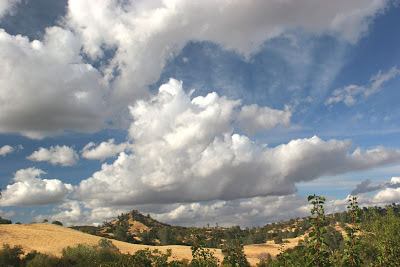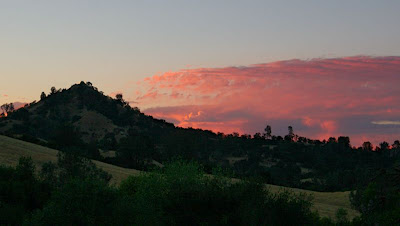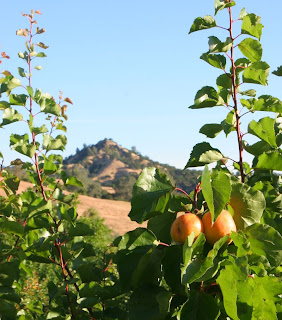The orchard trees are dormant and now it's time for their annual pruning. This job is essential for maintaining tree health and fruit production, and keeping their size manageable. It is a big job involving hundreds of cuts on each tree. But it's also a creative one, like a type of sculpture, where I get to guide the tree's form and hopefully maximize its health and vigor.
In a previous post I discussed some general principles and objectives of pruning stone fruit trees. These were:
- controlling tree size and shape
- stimulating growth of new fruiting wood
- opening up space for sunlight and air to reach all parts of the tree
- removing dead or damaged wood
Pruning tools
The photo above shows the basics - a three legged orchard ladder (the only type suitable for uneven ground), loppers for medium cuts, pruning saw for larger cuts, and bypass type hand shears for smaller cuts. Most importantly the tools need to be sharp and the pivots of the loppers and shears kept snug and oiled. Dull, loose tools make ragged cuts that will not heal quickly. I touch up my blades with a file or stone every few hours of use.
What to cut
Since most stone fruits are born on 2-3 year old shoots, always look for opportunities to remove older wood in favor of newer. The photo below left shows an older, silvery looking apricot shoot next to a newer, two year old shoot. The area is too crowded so the right side photo shows the older wood removed along with one shoot of the newer.
The photo below shows young apricot fruit spurs. These will bear for several more years so this branch would be a high priority to keep if possible. If the newest growth from the end is too long or hanging too low, that portion can be cut back to a few inches long.
The left side photo below shows the effect of pruning, namely that it stimulates future growth mostly right at the point of pruning. The red arrows show where two long shoots were cut back in January 2012, with the result that 2-3 buds near each of those cuts grew into very long shoots in the Spring. Left unpruned, this dense growth will shade out growth lower in the tree, will leave the tree taller than I want, will rub together in the wind, and with a heavy fruit set may break off. The right side photo shows the shoots thinned from 3 to 2, and the remaining ones shortened by 3/4 or more.
Dead wood can attract disease, adds to clutter in the tree, and can damage fruit that might rub against it in the wind. So always remove dead wood, even small twigs as pictured at right.
Where to make cuts
 The bigger the cut the more easily disease can enter the tree through the wound. And large saw cuts may never heal over completely. But careful and neat pruning can minimize the risk. When completely removing a side shoot from a branch you should avoid leaving a stub. This does not exactly mean cutting it off "flush" but rather just beyond the "collar." The photo at right shows the pruners positioned slightly away from the main branch, at the narrow point of the collar. This will leave a wound about half the size of one made perfectly flush to the main branch. It also creates the wound at an area of intense sap flow and hence faster healing.
The bigger the cut the more easily disease can enter the tree through the wound. And large saw cuts may never heal over completely. But careful and neat pruning can minimize the risk. When completely removing a side shoot from a branch you should avoid leaving a stub. This does not exactly mean cutting it off "flush" but rather just beyond the "collar." The photo at right shows the pruners positioned slightly away from the main branch, at the narrow point of the collar. This will leave a wound about half the size of one made perfectly flush to the main branch. It also creates the wound at an area of intense sap flow and hence faster healing.And by the way, applying a sealer or "wound dressing" has not been shown to speed healing and may even harbor disease organisms in pruning cuts.
When making heading cuts (shortening a branch rather than completely removing it), you can somewhat direct the resulting new growth. In the photo at right, the cut is made just above an outward facing bud. This will tend to encourage further spreading of the tree. But when a branch is already extended quite far you might choose to cut to an inward facing bud or side shoot.
 When heading a branch back to a lateral, that lateral should be at least one third the diameter of the branch being cut. Otherwise the lateral has little chance of surviving. The photo at right shows the wrong place to head back (red X) versus the better choice (removing completely at the green line). If a cut is made at the red line, the tiny lateral will be right next to a large wound and will likely die.
When heading a branch back to a lateral, that lateral should be at least one third the diameter of the branch being cut. Otherwise the lateral has little chance of surviving. The photo at right shows the wrong place to head back (red X) versus the better choice (removing completely at the green line). If a cut is made at the red line, the tiny lateral will be right next to a large wound and will likely die.The next two photos show a small apricot tree before and after pruning. Too-long shoots have been headed back to make the tree strong and stocky, and many have been removed to eliminate crowding and allow light penetration. All cuts were made with an eye toward replacing older wood with newer, keeping the tree to a workable height, and maintaining ladder access for thinning and harvest. Another critical point for our hot summer climate is leaving plenty of small shoots on the south and west facing branches to prevent sunburn. It's hard to show all this with two dimensional photos, but clicking on each to enlarge might give give you a better idea.
 |
| Before pruning |
 |
| After pruning |
- http://www.davewilson.com/homegrown/BOC_explained.html
- http://cesonoma.ucdavis.edu/files/27164.pdf
- http://homeorchard.ucdavis.edu/8058.pdf
- http://www.ext.colostate.edu/pubs/garden/07003.html
- http://cals.arizona.edu/pubs/garden/mg/pruning/fruit.html














































